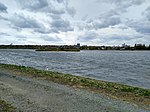Markfield Beam Engine and Museum
Buildings and structures in TottenhamEngine housesGrade II listed buildings in the London Borough of HaringeyGrade II listed industrial buildingsHistory of the London Borough of Haringey ... and 6 more
London water infrastructureMuseums in the London Borough of HaringeyParks and open spaces in the London Borough of HaringeyPreserved beam enginesSteam museums in LondonUse British English from August 2015

Markfield Road Pumping Station, now known as Markfield Beam Engine and Museum or sometimes just as Markfield Beam Engine is a Grade II listed building containing a 100 horsepower (75 kW) beam engine, originally built in 1886 to pump sewage from Tottenham towards the Beckton Works. The grounds of the building now form a public park known as Markfield Park. The River Moselle joins the River Lea at this location.
Excerpt from the Wikipedia article Markfield Beam Engine and Museum (License: CC BY-SA 3.0, Authors, Images).Markfield Beam Engine and Museum
Markfield Road, London
Geographical coordinates (GPS) Address External links Nearby Places Show on map
Geographical coordinates (GPS)
| Latitude | Longitude |
|---|---|
| N 51.581944444444 ° | E -0.061666666666667 ° |
Address
Markfield Beam Engine & Museum
Markfield Road
N15 4QF London (London Borough of Haringey)
England, United Kingdom
Open on Google Maps






